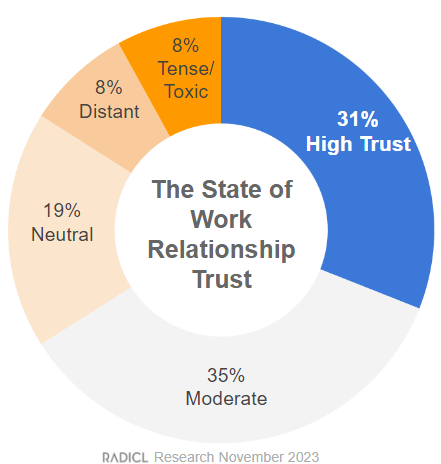
The Workplace Trust Imperative
By Ken Oehler, Ph.D.
Senior Partner, Head of People Science
The Quest for Productivity in a Low-Trust Environment
In our RADICL People Predictions for 2024, our first two predictions centered around continuing performance pressure and trust issues that businesses and people will face this year. Despite a continued stock market recovery in January, we have seen persistent inflated cost of goods and high interest rates; and 2024 began with a fresh round of layoffs across industries - increasing 136% in January. Between the ongoing layoff impacts and ongoing remote work debates, trust in the workplace is taking a hit as companies pursue productivity and profitability. RADICL’s research of a random sample of 500 U.S. employees collected in November 2023 shows that only 31% of people have high-trust work relationships. Worse, another 35% have neutral to toxic relationships.
Trust issues in the workplace are nothing new. According to Gallup, trust in leadership was as low as 17% in 2011, increased to a relative high of 24% in 2019, and then declined slightly to 21% in 2023. About 80% of employees have not completely trusted leaders, long before Covid and the remote work revolution. And, a Gartner survey showed that 4 out of 10 organizations, in return, do not trust their employees. Our current research shows trust gaps across many important work relationships; high trust is particularly low with executives, skip-level relationships and cross-functional (XFN) team relationships.
We have to start looking toward new solutions to rebuild, facilitate and maintain trust for people, as we could only expect getting people back in the office as…well, back to normal levels of low trust. Moving past the “where” of work and solving for the “what,” “who” and “how” of trusted work relationships is a leadership and management imperative for 2024 and beyond.

High levels of trust improve important outcomes like engagement, stress, and productivity (Zak 2017). However, trusted relationships are often discussed as a singular, diffuse concept or solely focused on leadership. Michael Arena (2023) highlights the opportunity for understanding and forging “discovery connections” that foster innovation across functional teams through Organizational Network Analysis (ONA) and AI. Further, Cross & Gray (2021) demonstrate how ONA can help identify when cross-functional clusters need to come together in person and which interactions can be virtual.
In order to support needed work relationship outcomes, we have to widen the aperture to understand the various relationships in a network. Our analysis examined how various network relationships, and various levels of trust within those relationships, impact EPIC Work Experience (Meaning, Clarity and Connection) and productivity outcomes.
The Impact of Trusted Relationship Networks
Our research reveals four important work relationship dynamics:
People get different types of value from different relationships. We see managers have the most impact across outcomes. However, when it comes to different outcomes, people get the most meaning from executives and the most clarity from mentors. Mentors, skip managers and the direct team can have significant impact on feelings of trusted connection. And, executives and work friends add to the managerial impact on productivity.
Indirect, distal relationships matter a lot. Two-thirds of the trust impact comes from relationships outside of the direct manager or direct team. High-trust relationships with executives, mentors, XFN team members, skip managers and work friends account for the majority of work impact.
Trust has a non-linear impact on productivity. With a relatively high (79%) baseline level of productivity, there is important, but limited, upside potential with high trust. There is more significant downside to lack of trust. Further, “distant” relationships can be as damaging as “tense/toxic” relationships, with up to a 40-point erosion in productivity.
Managers are likely overburdened. Managers account for only 28% of the productivity impact and 20% of the impact on work experience. There is also a paradoxical, positive impact on manager’s own productivity with a “distant” relationship with reports - perhaps indicating (too much) time spent managing (too many) people could hinder manager efficiency.
Design Intentionally for a Network of Trusted Connections
As hybrid and distributed work stabilizes at an average of 1.5 remote days a week (Barrero, Bloom, Buckman & Davis, January 2023) and 19% of people are working co-located with their direct team (RADICL), solving for trusted and productive relationships across multiple work settings becomes critical for 2024 and beyond. Trusting someone takes time. And building a trusted network takes even more time. Frei and Morriss (2020) outlined 3 critical ingredients of trust as logic (confidence in reasoning and competence), authenticity and empathy. Similarly, Zenger & Folkman (2019) outlined good judgment/expertise, consistency and positive relationships as critical ingredients of trust.
In order to boost these trust drivers that build and protect productive relationships in our distributed work reality, we recommend considering four design elements:
Leadership & Culture
A workplace with trusted relationship networks represents a culture shift, and starts with what leaders say and do. Zak (2017) points us to some critical trust-building leadership behaviors of presenting clear, achievable goals, recognizing excellence, empowering work, openly sharing information, fostering social relationships, focusing on whole-person growth and asking for help. Psychological safety in a hybrid environment requires leaders to foster sharing of individuals’ work needs and collective ownership of outcomes, to candidly share their own hybrid challenges, to recognize when transparent sharing has positive impact, and to protect the vulnerability of others (Edmondson & Mortensen, 2021).
Distributed Work Processes
People need clarity about when, and when not, to come into an office. Microsoft research identified social events, onboarding and team kickoffs as critical in-person moments that matter. Atlassian’s 1,000 Days of Distributed Work found that three in-office team meetings per year are likely sufficient, showing a 27% boost in connection that lasts 4-5 months. This leaves a lot of time to allow people to work from home on focus work or collaborative work that can be done asynchronously. Allowing this flexible work autonomy is also a sign of trust in the employee that likely builds reciprocal trust in leaders through a show of sound reasoning and empathy.
Office Redesign
Building trust doesn’t always require a building. However, some work may be most effective on-site and office design should align with these work needs. Atlassian’s research also focused on office reallocation and redesign for connection, company belonging and a place to get work done. RADICL’s State of the Work Experience research from May of 2023 found that rightsizing space for sound and energy with sufficient meeting rooms/technology to support in-person and hybrid meetings are the top office design needs. Simultaneously shrinking the total real estate footprint with a more functional redesign presents a significant cost savings and profit-boosting opportunity.
Work Technology
People have access to a multitude of technology apps for project management, collaboration, chat, video conference, surveys and talent management. However, there are significant gaps in employee-centric content and design that integrates and nudges the insights, empathetic connections, and authentic behaviors that build productive, trusted relationships. ONA, matching algorithms and AI present untapped opportunities to accelerate the trusted connections people need. For example, imagine employee-facing technology that could proactively facilitate trust-building practices of high-performing teams like sharing skills, communication and work preferences while planning collaboratively (Friedman, 2024). Work technology that helps people better understand themselves and others at scale can strengthen trusted networks across teams, levels and organizations, and significantly improve individual and organizational effectiveness.
In Work We Trust
This is personal. People put a lot of themselves into their work. They bring their history, personal lives, personality, work preferences, motivations, networks, experiences and skills to work - not simply their discretionary effort and impact. People and organizations need a network of trusted relationships in order to survive and thrive. Trust efforts in the workplace are either too diffuse or seen too much as the manager’s responsibility. Trusted connection comes from many different sources, with perhaps some of the greatest impact opportunities in strengthening distal relationships with mentors, XFN teammates, work friends, skip managers and executives. Shifting design energy to the “who, what and how” of work (away from the “where”) presents a business imperative to redesign cultures, policies, workplaces and technology to help build and maintain the trusted connections that people and organizations need to thrive. It all starts with a true understanding of other people as individuals.








